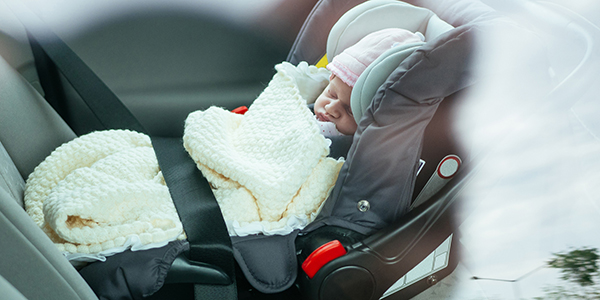Car Safety

- Car accidents are a leading cause of death in babies and children, as well as a major cause of permanent brain damage, epilepsy and spinal cord injury. Most of these deaths and injuries can be prevented with the proper use of car safety seats. A sudden stop at 30 miles an hour can have the same crushing force on your child’s brain and body as a fall from a three story building. California State law (V.C. 27360) requires all children under age eight or weighing less than 80 pounds to be placed in a federally approved child restraint system when riding in the car. Everyone in the car should be properly buckled up every time. The police or Highway patrol may issue tickets if you are not buckled up. Never hold your baby in your lap while riding in a car, even for a short ride.
- California law requires children to ride in the back seat, if available in a child restraint device until they are at least 8 years old or weigh 80 pounds.
- Read all car seat instructions, and check the owner’s manual of your car before installing the car seat into the car.
- Always use the correct car seat for the age, weight and height of your child. A car seat with a 3 or 5 point harness is recommended by safety experts. (5 point harness is safest.) Do not use infant carriers, travel beds, backpacks carriers, etc. in place of a car seat.
- It is always safer to purchase a new car seat for your child. If you use a second hand car seat, make sure you have the instructions for the seat, that the car seat has not been recalled, and verify that it has never been involved in an accident. Do not use a seat older than 6-10 years.
- Car seats that have been involved in a crash should not be used. Even if there is no visible damage, the plastic shell may be weakened. Insurance companies in California are required to replace car seats that were involved in a crash if the child was in the seat at the time of the collision and the insurance company is paying for damages.
- Infants less than one year and less than 20 pounds must be placed in a rear facing car seat. Most infant carrier style car seats can only be used until 20 pounds. After that, use a convertible car seat still rear facing. Make sure that the car seat is rated to at least 30 pounds rear facing.
- The rear facing car seat should be in a semi-reclining position at a 45 degree angle.
- Never place an infant in the front seat with a passenger side airbag. The back seat is always the safest place for your infant or child. In fact, children 12 years old and younger are safest in the backseat.
- Check to make sure that the car seat is installed tightly into the car. It should not move more than one inch side to side. Check the owner’s manual of the car to find out how the seat belts lock or whether you need to use a locking clip. A new system called LATCH may help with installation problems but only if both the car seat and the car have this new system.
- On warm or hot days, check the metal parts of the car seat to make sure they are not too hot. You may wish to cover a car seat that is left in the car with a towel when not in use.
- Do not wrap baby in blankets or heavy clothing before placing in the car seat. Do not place extra padding under the baby. Secure infant snugly with harness straps and then cover with a blanket if desired.
- Harness straps should be snug with room for only one finger at the collar bone. After adjusting the harness, check to make sure it is secure.
- The baby’s buttocks and back should be flat against the back of the seat.
- Harness straps should come out of the slots that are at or below the level of the baby’s shoulders when facing rear.
- The harness retainer clip should be secured at the level of the armpits.
- If you have trouble installing you car seat or have questions, contact a Certified Child Passenger Safety (CPS) Technician, attend a car seat safety course, or visit a car seat check-up in your area. The California Highway patrol has CPS technicians that can help you correctly install a car seat. Often law enforcement agencies, public health departments and hospitals have these technicians available to help you. Take the time to make sure that your child is correctly restrained. It may be the difference between life and death in a crash. You may also get more information by visiting the National Highway Traffic Safety Administration (NHTSA) online at www.nhtsa.dot.gov or by calling (888) 327-4236.
- Contact your child’s healthcare provider for information on the low cost car seat programs serving your area or contact Safe Kids at (916) 244-1964.
- Never leave a child alone in a vehicle, not even for a minute. There are many things that could happen to your child, such as heat stroke or being taken during a car theft or kidnapping. California law (V.C. 15620) states: A child 6 years old or less may not be left alone in a vehicle if the health or safety of the child is at risk, the engine is running, or the keys are in the ignition (unless supervised by someone at least age 12).









